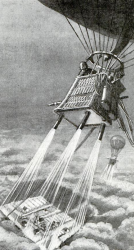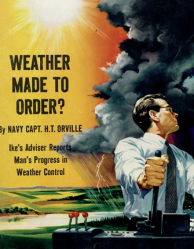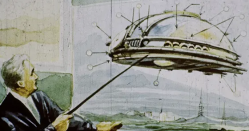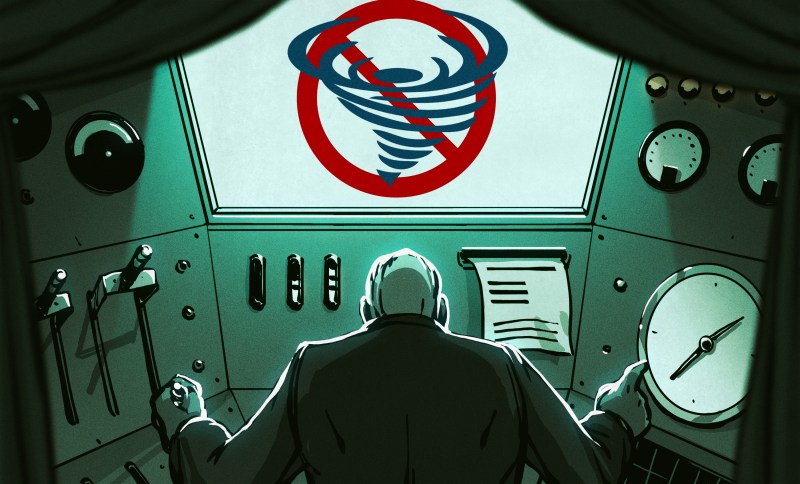It used to be a common expression to say that something would happen when “people walked on the moon.” That is, something that was never going to happen. Of course, by 1960, it was clear that someone was going to walk on the moon eventually. There were many other things everyone “knew” would happen in the future. Some of them came true, but many of them didn’t. Some, like video phones and robot factory workers, came true in a way, but not as people imagined. For example, people were confident that computers would easily translate between human languages, something we still have trouble doing entirely reliably. Another standard prediction is that people would control the weather.
Controlling the weather, in some ways, seems even less likely than walking on the moon. After all, we know where the moon is and where it will be. We still don’t understand precisely what causes the weather to behave the way it does. We have models and plenty of scientific theories. But you still can’t know exactly what’s going to happen, where, or when.
History
If you farm or live in a hut, weather is especially important. You want rain but not too much rain. Without scientific knowledge, many cultures had rain-making superstitions like a rain dance or other rituals meant to encourage rain. Some think that loud noises like cannon fire prevent hail. Charlatans would promise rain in exchange for donations.
However, science would eventually surface, and in the 1800’s James Espy — the first U.S. meteorologist — theorized that convection was what really caused rain. He had bold plans to set massive fires to encourage rain but could not convince Congress to go along.
Half a century later, Robert St. George Dyrenforth tested the effect of explosions on rainfall. There is no evidence that his cannon and fireworks did anything. He did, however, claim credit for any rain that happened to occur nearby. There have been many reports that explosions cause rain — rain often falls after a heated battle, apparently. The government in Thailand tried to induce rain using dry ice flakes dropped into clouds with, reportedly, some success. Abu Dhabi, Russia, and China’s governments claim to have working weather control today.
Effects

Exactly what you want the weather to do depends a lot on where you are and when. While farmers want rain, coastal dwellers want hurricanes to dissipate. People on the plains don’t want tornadoes, and aviators don’t want fog.
In the early 1920s, electrically charged sand cleared fog and, reportedly, created rain as part of a Cornell chemist’s project sponsored by the Army. In May 1923, Popular Science Monthly featured an article: “Is Rainmaking Riddle Solved?” featuring the work with charged sand.
However, by 1925, despite the positive press, things had not gone well, and the military withdrew air support. This effectively ended the program. MIT scientists tried spraying calcium chloride from pipes over an airfield to break fog. It didn’t work well, but it did lay the foundation for modern airport deicing systems.
Hot and Cold War
The British used a surefire way to drive off fog from airfields during World War II. Just as Espy proposed decades earlier, they burned 100,000 gallons of petrol an hour to drive off fog. Coincidentally, the process also heated and lit the landing strips. For war purposes, it was effective, but the cost was too high for commercial use.
By 1946, General Electric was experimenting with seeding clouds with dry ice and silver iodide and tried diverting hurricanes, but with no apparent effect. They did, however, drop dry ice into a cloud to stimulate a snowstorm.

The real heat — no pun intended — came with the cold war. According to NASA, a hurricane can produce as much energy as 10,000 bombs. If you could send a hurricane over to your enemy… In 1954, Collier’s had a cover with a man in office attire controlling the weather with a lever. Schemes including using pigments on the polar ice caps to cause flooding, saturating the stratosphere with dust, and even pumping water out of the Bering Straits.
[Harry Wexler], head of research at the U.S. Weather Bureau, predicted that an adversary could use chlorine or bromine to rip a hole in the Earth’s ozone layer. But weather control wasn’t only something the West dreamed about. The Soviet Union assumed that by 2017, you might have a job at the “Central Institute for Weather Control.”

However, after cloud seeding was secretly used in Vietnam (Operation Popeye, an attempt to lengthen the monsoon season in Southeast Asia), a UN convention agreed to prohibit the hostile use of environment modification techniques.
Cloud Seeding
Speaking of cloud seeding, although GE’s original plans for it didn’t work out, it does appear to be at least somewhat effective. Modern understanding of the technique is that it is only effective in cases where water is already in the air. So it was probably going to rain soon, anyway. Still, the technique may be useful for making it rain right here and right now, for cases where that is important.
Cloud seeding has also attempted to weaken hurricanes. In fact, there have been many proposals and tests ranging from soot, which didn’t seem to do much, to barges with jet engines to disrupt the storm’s airflow, which, as far as we know, has never been tested. One problem is that the amount of force in a hurricane is difficult to grasp — it is huge. Jet engines or absorbent polymers — another proposed solution — would have to operate on a gigantic scale to make much of a difference.
Slippery Slope
Stop hurricanes and tornados? Yes, please. But then again, the weather is a complex system, and we don’t always understand how changing one thing that seems like a good idea can have unfortunate unintended consequences. That, of course, is assuming you don’t have bad intentions. Weather warfare and terrorism are frightening prospects.
So far, real weather control is the stuff of science fiction. But so were robots, video phones, and trips to the moon. So it seems likely we will get there one day. We just have to hope we are smart enough to handle it.
















Going to leave a comment here stating that “Did you know? HAARP isn’t just a mysterious conspiracy theory—it’s actually a ham radio station!” KL7ERP
I wish people would quit harping about that!
“Wait 5 seconds…… (Rain stops)… Right on the tick… Amazing.. Absolutely amazing… Too bad the post office isn’t as efficient as the weather service..” – Doc Brown – Back To The Future 2
Don’t forget a certain world leader once proposed nuking hurricanes!
¯\_(ツ)_/¯ Gotta nuke something
On a scale of a tornado a swarm of drones flies in a circle to counter the the spin with a combined massive rocket thrust or shaped explosives, enough to get it off of the ground?
I agree with what Von Neumann said in 1955
“Fortune published a prominent article by John von Neumann: “Can We Survive Technology?” referred to climate control through managing solar radiation or changing the earth’s heat budget as a thoroughly “abnormal” industry that could have “rather fantastic effects” on a scale difficult to imagine. Von Neumann, a noted mathematician and pioneer in computerized weather forecasts and climate models, pointed out that altering the surface reflectivity of specific regions or redirecting air masses in an attempt to trigger a new ice age were not necessarily rational undertakings. Tinkering with the earth’s heat budget or the atmosphere’s general circulation, he claimed, “will merge each nation’s affairs with those of every other more thoroughly than the threat of a nuclear or any other war may already have done.” In his opinion climate control could lend itself to unprecedented destruction and to forms of warfare as yet unimagined. It could alter the entire globe and shatter the existing political order. He made the Janus-faced nature of weather and climate control clear. The central question was not “What can we do?” but “What should we do?” This was the “maturing crisis of technology” for von Neumann, in which technological realities and possibilities—from nuclear warfare to climate engineering—might undermine the very existence of nation states and the treaties and ties that bind them. ”
Nuff said.
^^^ AKA “How to Kill a Comment Thread”